Goat Milk Soap Recipe: quick and easy
This easy goat milk soap recipe uses a melt-and-pour goat milk soap base, shea butter, and essential oils. This is an excellent recipe for first-time soap making.
I have wanted to make handmade soap to give along with my hand-knit washcloths for a while, but have been intimidated by using lye and the list of needed equipment. Honestly, my craft room is already chock full of supplies and ingredients needed for various projects, and I wasn’t anxious to add more.
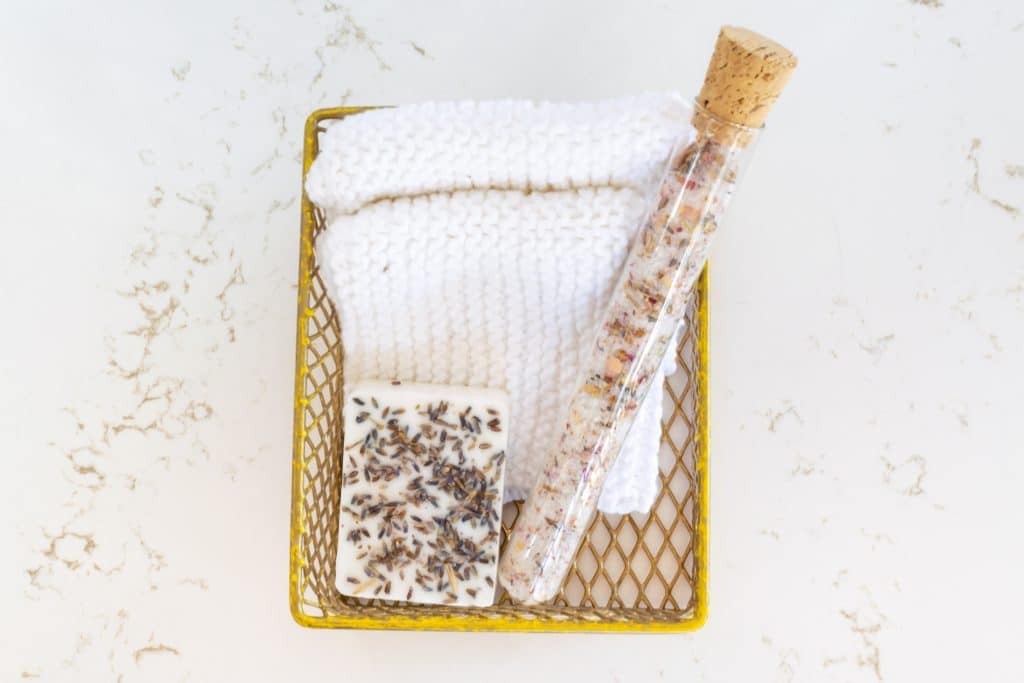
Table of Contents
enter melt-and-pour soap bases!
Melt-and-pour soap bases have already gone through the saponification process of cold process soapmaking. Saponification is the chemical reaction of a lye solution (sodium hydroxide) combined with oils. Once saponification has occurred, your soap will have no actual ‘lye’ remaining.
Using a melt-and-pour soap base just cuts out several of the steps, most of the equipment, and much of the time involved with making cold process soap from scratch. Regarding time-saving, using a melt-and-pour base takes a 4-6 week process down to…a day! Have I mentioned I’m partial to immediate gratification projects?!
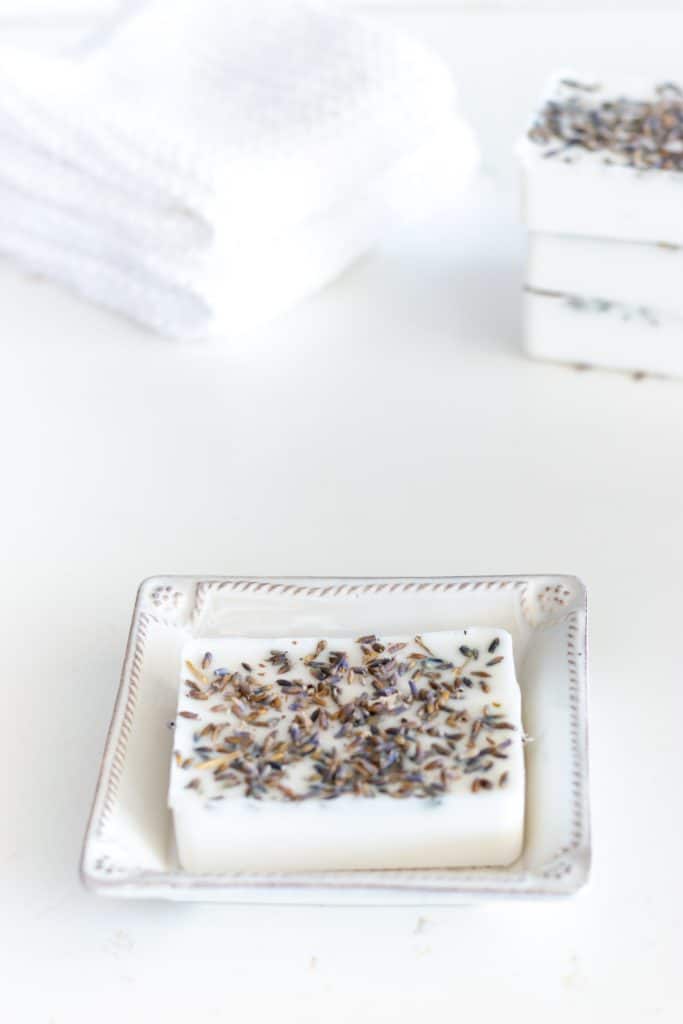
ingredients in soap
Some of these links may be Amazon affiliate links and I may earn a small commission from the sale of these products to help defray the costs of operating this site, but the price you are charged is not affected. You can see my full disclosure policy here.
The most basic ingredients in soap are oil, liquid, and lye. The options for the oils used are endless! Shea butter, cocoa butter, mango butter, coconut oil, extra virgin olive oil, jojoba oil, and avocado oil are all suitable options.
Solid oils like shea butter, cocoa butter, and mango butter will produce a harder bar of soap than liquid oils like olive oil, coconut oil, and jojoba oil.
Let’s dive deep into the ingredients, and why they are there in the goat milk soap base I use.
Glycerin, Coconut Oil, Palm Oil, and Safflower Oil are the oils.
Goat’s Milk and Water are the liquid.
Sodium Hydroxide is the lye.
Sorbitol is a sugar that, among other beneficial things, improves lather. In addition to Sorbitan Oleate, it is an alcohol/alcohol derivative that helps the soap to have a lower melt point – making a cold process soap re-meltable.
Oat Protein helps boost the moisturizing properties of soap by helping hold water to the skin.
Titanium Dioxide is a mineral whitener used in opaque soaps.
benefits of goat’s milk soap
Goat’s milk is filled with essential nutrients and vitamins like vitamin C, B1, B6, B12, and E. The lactic acid (alpha hydroxy acid) in goat’s milk is known for its gentle hydration. AHA also helps exfoliate dead skin cells. Research also suggests that low AHA concentrations may help sun-damaged skin.
The natural emollients and triglycerides in goat’s milk help moisturize our skin.
Goat milk is rich in both unsaturated and saturated fats, making it ideal for a soap base. Saturated fats increase a soap’s lather, while unsaturated fats provide moisturizing and nourishing properties
can you add additional ingredients to melt-and-pour soap?
You can add additional ingredients to melt-and-pour soap in small amounts, but you don’t have to!
As you note from the ingredient list above, there are already plenty of oils in the soap, so you would want to keep any additional oils to a minimum, or your soap may not lather well, may sweat, or not cure properly. Remember that melt-and-pour soap has already gone through the chemical process to become soap.
As a general rule of thumb, you want to keep your additions to no more than 1 – 2 teaspoons per pound of melt-and-pour soap. That includes everything, including essential oils. It doesn’t include any dried herbs or flowers you add.
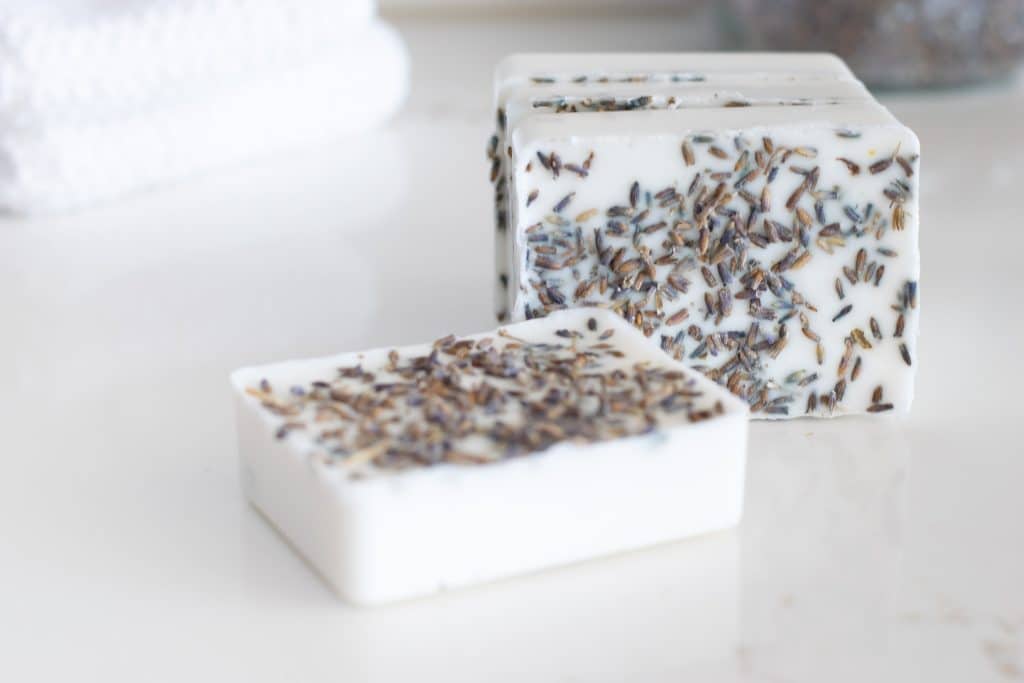
adding dried herbs and flowers to this goat milk soap recipe
I sprinkled dried lavender on top of my soap. Some dried herbs (think calendula) might bleed their color into your soap. So go cautiously there. Also, in humid conditions, dried herbs and flowers may absorb some of the moisture in the air and then release that moisture into your soap.
Another thing to remember is that many flowers lose their color once mixed into your soap ‘batter’ and just become brown.
You run the risk of mold with fresh herbs and flowers, so I avoid using them in my soap. But, for my next bars, I plan to pulverize dried rosemary and mix it in the soap batter.
UPDATE (10/23/2023) When I make bars again, I don’t think I will sprinkle dried herbs or flowers on top. It looks pretty…for a bit. Once you start washing with the soap it loses the initial appeal and starts to look a little yucky…IMHO.
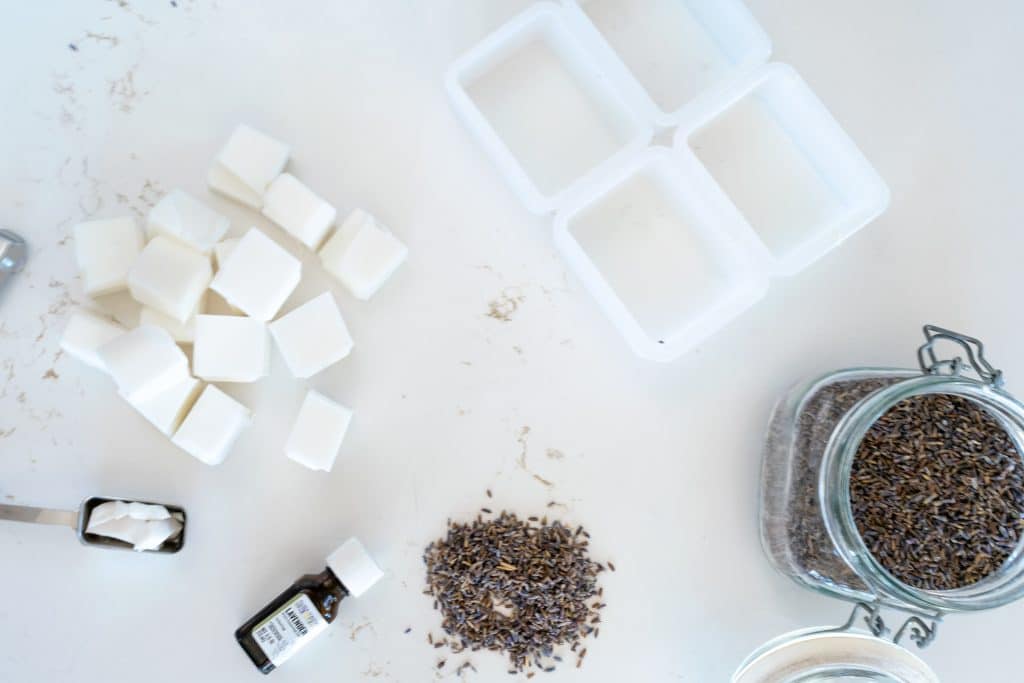
what I used for my goat milk soap recipe
I made two versions of this goat milk soap recipe, one with added honey and one without. The honey made the soap more beige than white. I don’t notice any difference in the soap’s hardness or lather. They both lather nicely.
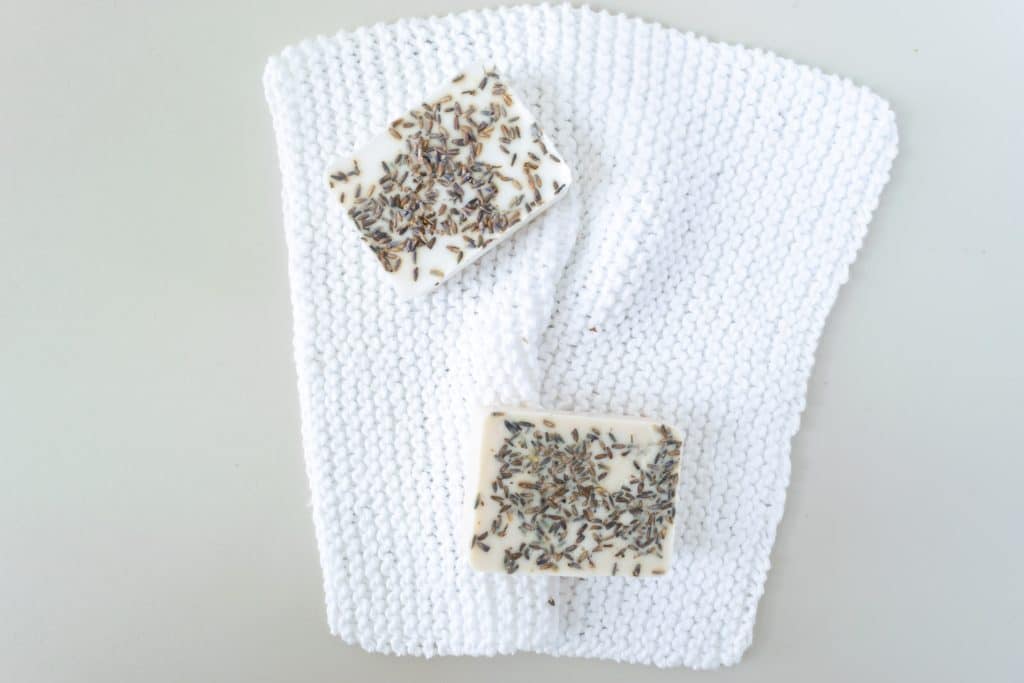
- Soap Molds I used a simple 3″ x 2″ x 1″ rectangular mold.
- White Cocoa Butter (optional) I have cocoa butter already, as I use it for this hand balm recipe. If you don’t already have it or something similar, like cocoa butter or mango butter, you don’t need it. Most bases have all the oil they need.
- Honey (optional) can be added at 1/2 teaspoon per pound. Once again, when adding any liquid to melt-and-pour, keep the total of all added liquid ingredients under two teaspoons per pound of the base to ensure that you don’t affect the soap’s chemistry. I used dark manuka honey, which was all I had, making the soap more beige than white.
- Essential Oils (optional) You don’t need essential oils to make your soap. As is, the melt-and-pour Goat Milk Soap base has very little, if any, fragrance. If you want to make unscented soap, then just use it as is. But if you don want to add fragrance, choose your favorite essential oil suitable for the skin. Many potpourri, candle, and other craft oils are not meant for skin contact. I have used the Aura Cacia brand of essential oils for all my skincare projects and have never had a problem. Some of the scents to consider are:
- lavender
- rose
- geranium
- patchouli
- rosemary
- clary sage
- A spray bottle with isopropyl alcohol (will dissipate any bubbles that form from mixing and pouring your soap.
how to make soap with a melt-and-pour base
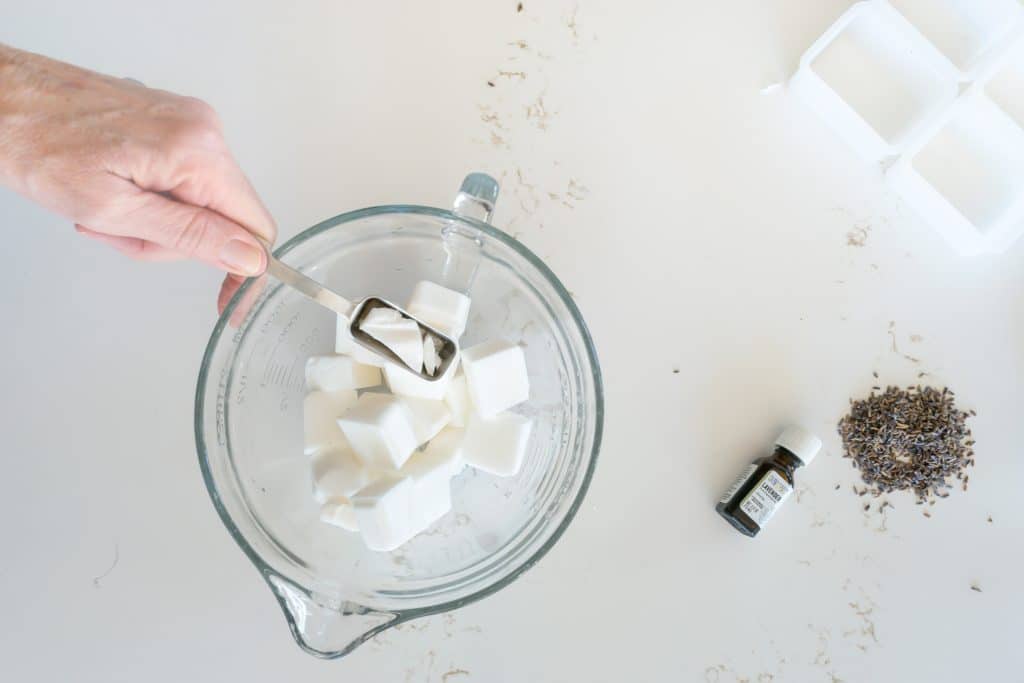
Place chopped pieces of soap base into a microwaveable bowl with a pouring spout. Add any solid butter at this time (optional)
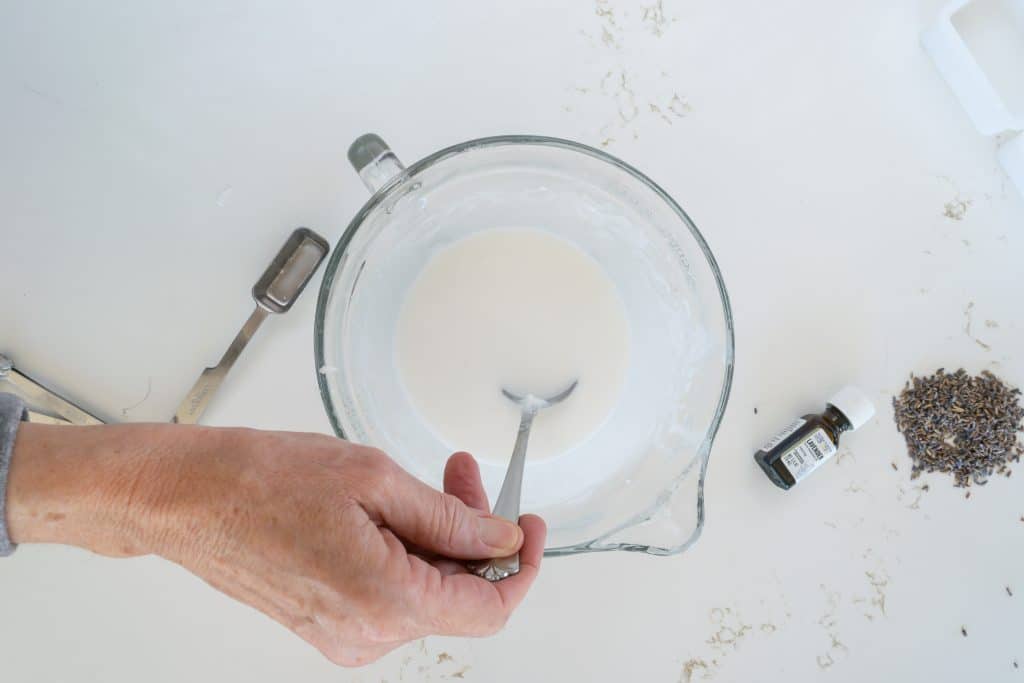
Microwave on high in 15- 20 second intervals, stirring after each interval. Continue until just melted. Don’t overcook it!
Remove and gently stir; you don’t want to make bubbles.
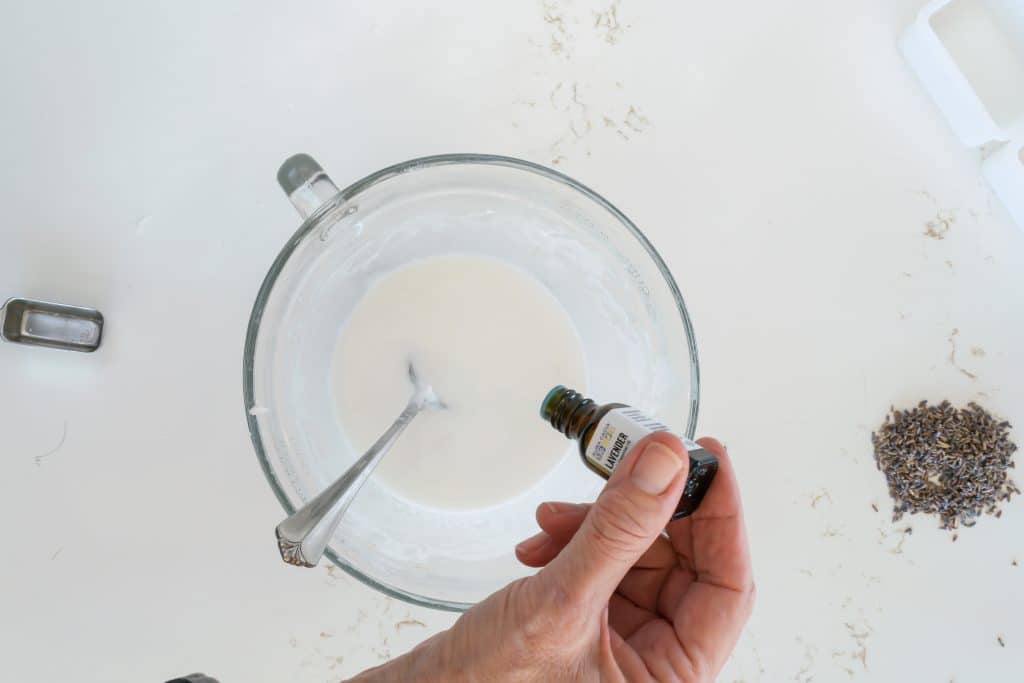
Add essential oils (optional). Keep total liquid additions to less than 2 tsp per pound of soap base. Stir gently to incorporate.
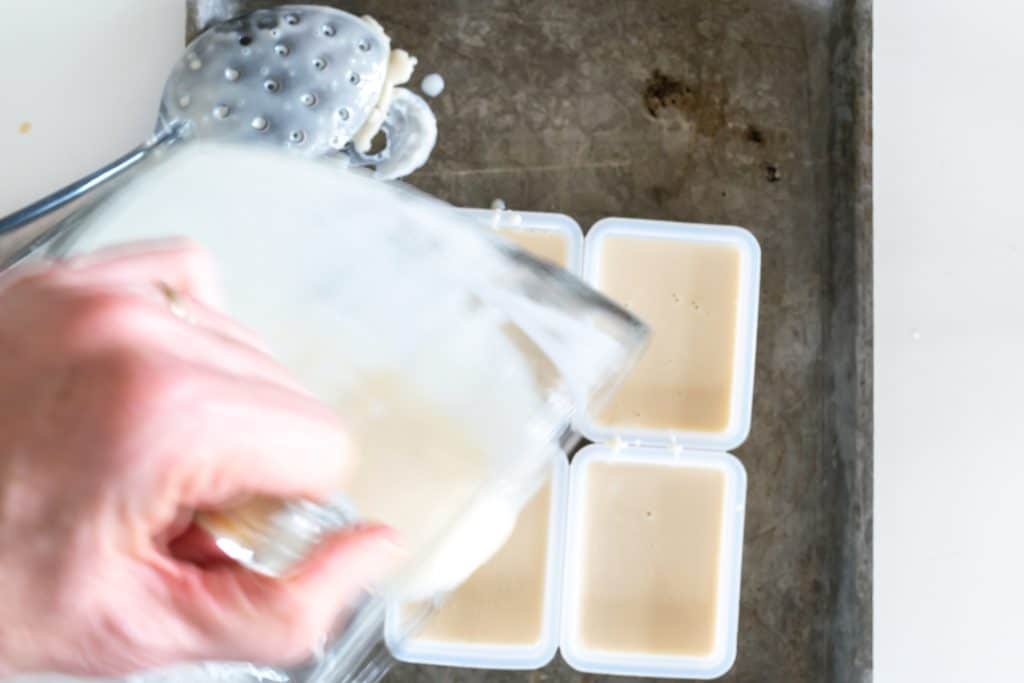
Pour into the soap molds.

Spritz with isopropyl alcohol to remove any bubbles, and sprinkle with dried herbs or flowers.
Let sit undisturbed for 4-6 hours or until solid. Wrap well to prevent glycerin dew.
more handmade bath + body items
If you like making goat’s milk soap, you might also enjoy making some of these other bath + body items. All of these items are great paired with a lovely hand-knit or crocheted washcloth or just on their own. Make an assortment of handmade bath + body items and package them in a nice basket or container.
- Moisturizing Hand Balm
- Herbal Bath Salts
- Heel Balm
- Lavender Microwavable Neck Wrap
- Hand Knit Washcloth Patterns
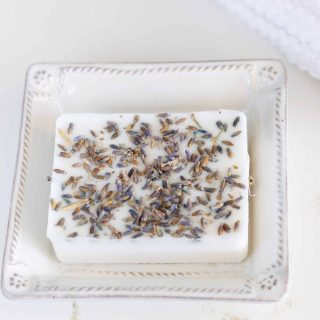
Goat Milk Soap with Melt-and-Pour Base
Equipment
- A microwaveable glass bowl. I used my large 2 quart glass batter bowl.
Ingredients
- Soap Molds I used a 3.1″( L ) X 2.3″(W) X 1.3″(H) rectangle mold like this.
- 1 pound Goat Milk Soap Base
- 1 Teaspoon Essential Oils I used Lavender (optional) (SEE NOTE A)
- I had some Shea Butter so I added a little bit (optional) (SEE NOTE B)
- Spray bottle with 99% Isopropyl alcohol
- Dried lavender buds
Instructions
- Cut the soap base into 1" squares.
- One pound of soap base will make 4 bars of 3"x2"x1" soap, so don't melt more than the number of molds you have.
- If you are adding any additional solid butters, add them now. KEEP ALL ADDITIONS, INCLUDING ESSENTIAL OILS, TO LESS THAN 2 TEASPOONS PER POUND OF SOAP BASE.
- Microwave in 15- 20 second intervals, stirring after each interval. Continue until just melted. Don't overcook it!
- Add essential oils and any other liquid oil (See NOTE A and B)
- Pour melted and scented soap into your soap molds.
- If bubbles develop, spritz them with the alcohol.
- Sprinkle with dried lavender (optional)
- Let sit undisturbed for 4-6 hours or longer, depending on humidity. Make sure it has fully hardened before removing the soap from the molds.
Notes
Bookmark this page or pin the following image to refer back to this Goat Milk Soap Recipe in the future.
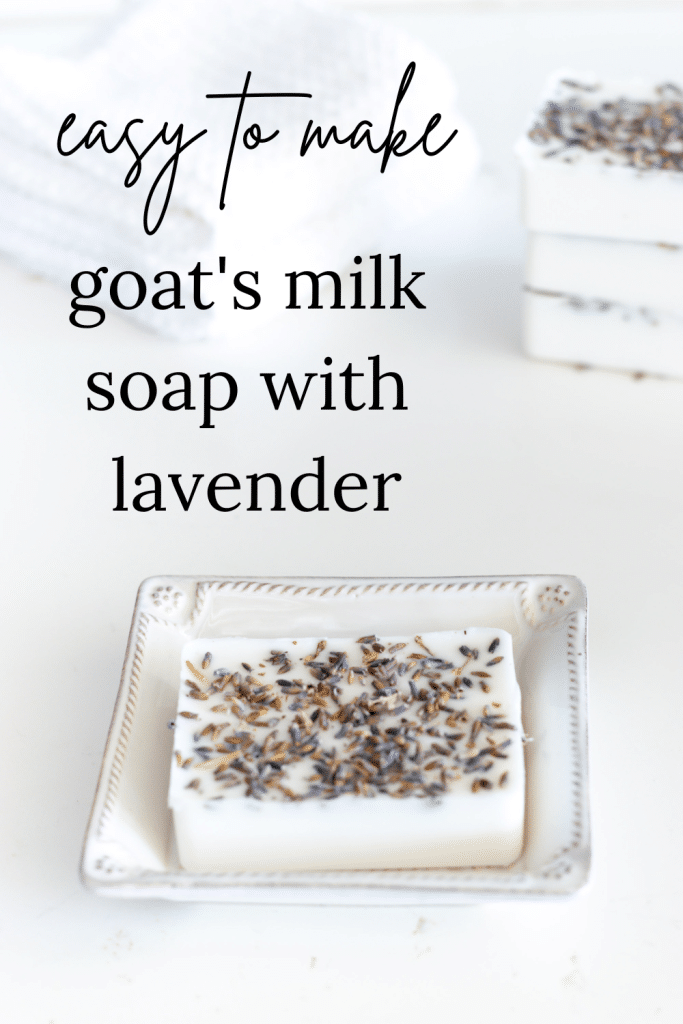
Thanks so much for spending a few minutes of your busy day with me!
To ensure you don’t miss future content, pop your email in the pale green box on the right or click here. I usually send one email weekly, so I won’t inundate your inbox. I’m sensitive to an overflowing email inbox!
We will only use your email address to send you emails, no more than 1-2 weekly. In addition, you will have access to my growing library of knit & crochet patterns and other printables. Check back often as this library will continue to grow. You can unsubscribe anytime by emailing me or clicking on the “unsubscribe” link at the bottom of all emails.
And you can access many of the products I refer to on my Nourish and Nestle Amazon Page. You can access it here.
So, if you’d like to participate in the ‘subscriber benefit’ action, simply subscribe to Nourish and Nestle here or use the form on the right sidebar. It’s slightly towards the top.
I have sent all my subscribers the link to the Subscriber Benefits Library. If you missed it or misplaced it, let me know.
Until next time…


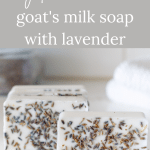
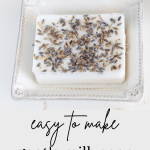
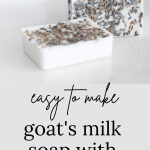
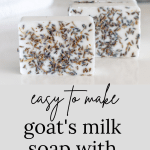
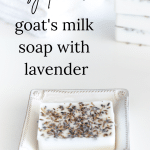
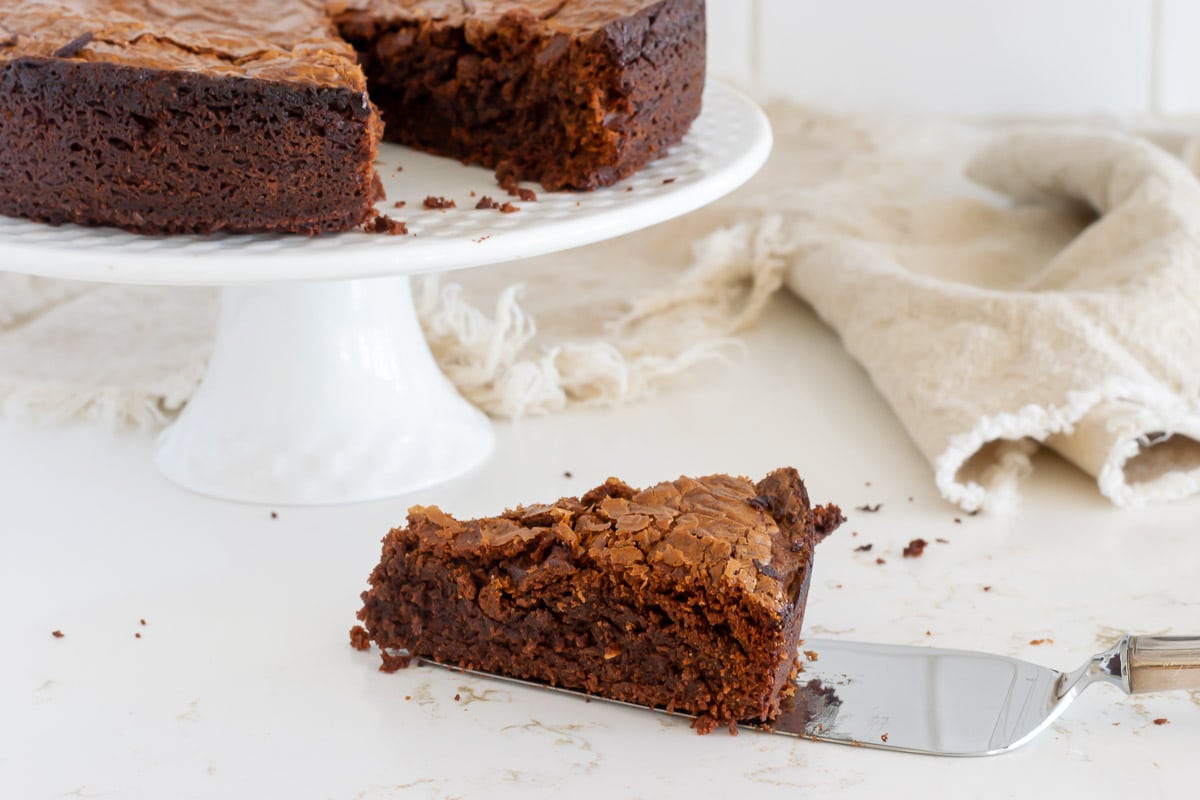
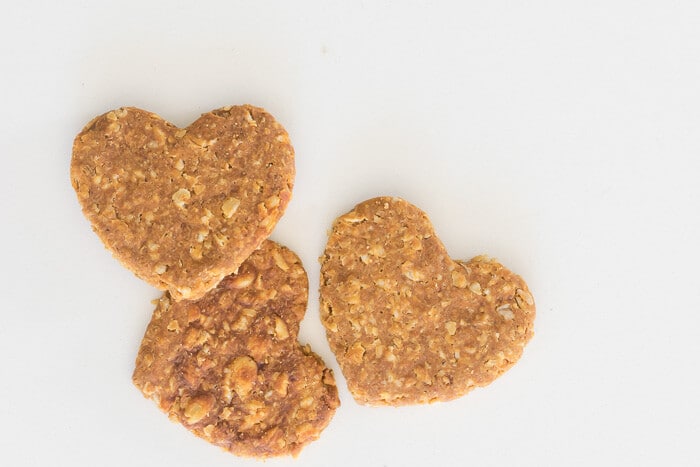
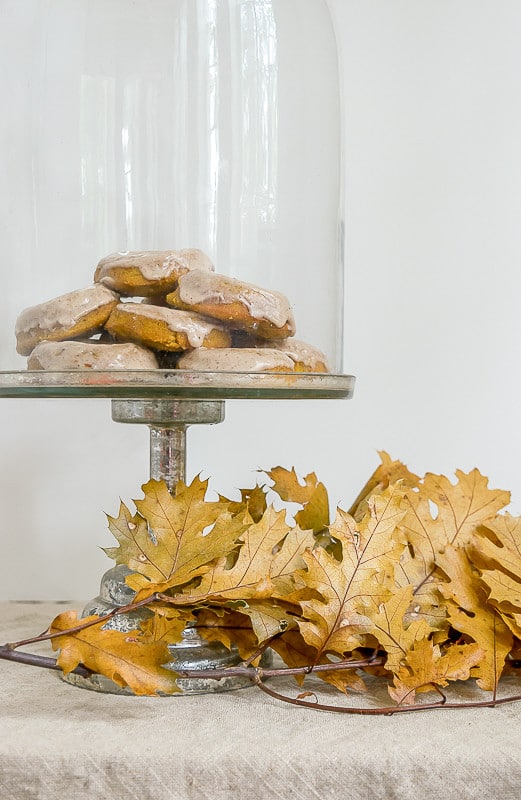

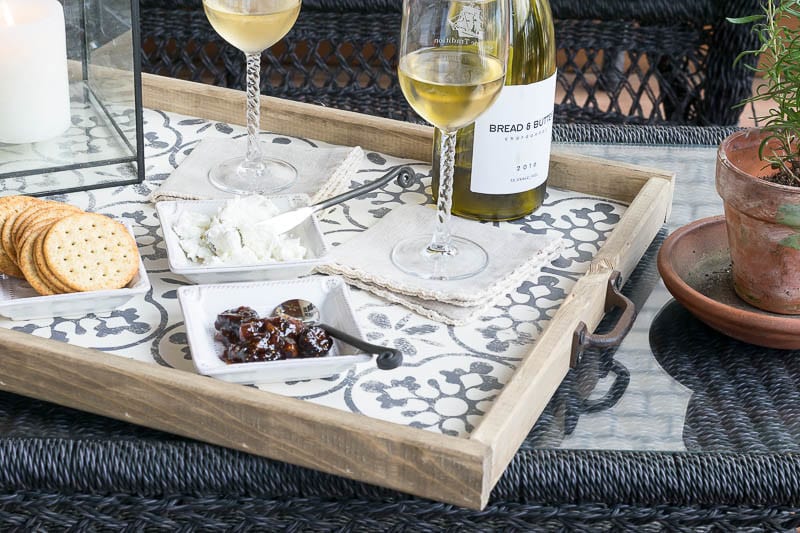
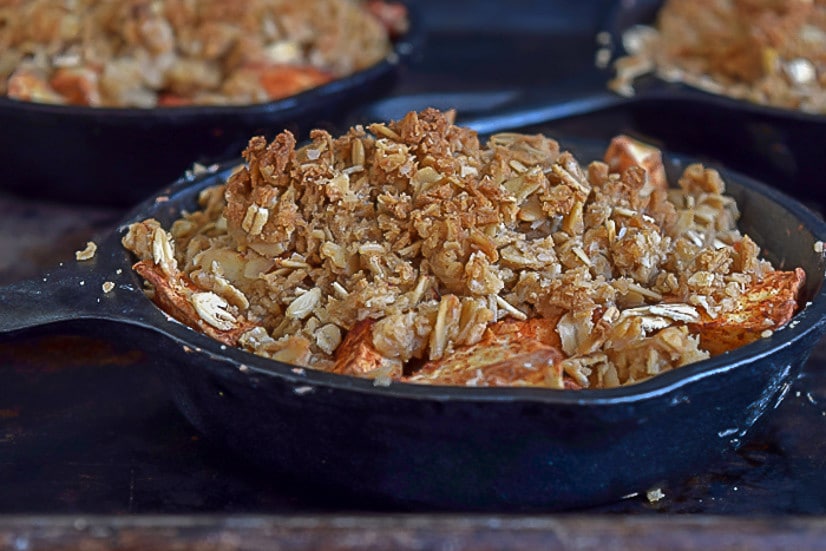
This goat milk soap recipe is so easy and fun to make! I love that it uses a melt-and-pour base, which saves a lot of time and effort. The addition of lavender and honey makes the soap smell wonderful and feel so soothing on the skin. Highly recommend trying this if you’re new to soap-making!
Thanks!